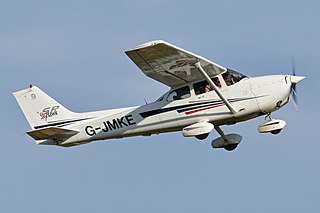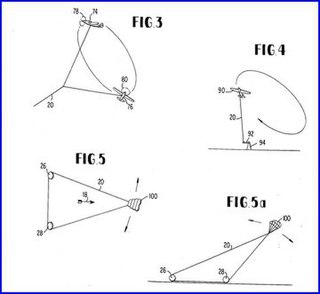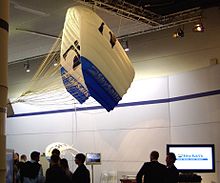
An aircraft is a vehicle that is able to fly by gaining support from the air. It counters the force of gravity by using either static lift or the dynamic lift of an airfoil, or, in a few cases, direct downward thrust from its engines. Common examples of aircraft include airplanes, helicopters, airships, gliders, paramotors, and hot air balloons.

An electric boat is a powered watercraft driven by electric motors, which are powered by either on-board battery packs, solar panels or generators.

Unpowered aircraft can remain airborne for a significant period of time without onboard propulsion. They can be classified as gliders, lighter-than-air balloons and tethered kites. In the case of kites, lift is obtained by tethering to a fixed or moving object, perhaps another kite, to obtain a flow of wind over the lifting surfaces. In the case of balloons, lift is obtained through inherent buoyancy and the balloon may or may not be tethered. Free balloon flight has little directional control. Gliding aircraft include sailplanes, hang gliders, and paragliders that have full directional control in free flight.
Kite types, kite mooring, and kite applications result in a variety of kite control systems. Contemporary manufacturers, kite athletes, kite pilots, scientists, and engineers are expanding the possibilities.

The Age of Sail is a period in European history that lasted at the latest from the mid-16th to the mid-19th centuries, in which the dominance of sailing ships in global trade and warfare culminated, particularly marked by the introduction of naval artillery, and ultimately reached its highest extent at the advent of the analogue Age of Steam. Enabled by the advances of the related Age of Navigation, it is identified as a distinctive element of the early modern period and the Age of Discovery.

A zero-emission vehicle, or ZEV, is a vehicle that does not emit exhaust gas or other pollutants from the onboard source of power. The California definition also adds that this includes under any and all possible operational modes and conditions. This is because under cold-start conditions for example, internal combustion engines tend to produce the maximum amount of pollutants. In a number of countries and states, transport is cited as the main source of greenhouse gases (GHG) and other pollutants. The desire to reduce this is thus politically strong.

A rotor ship is a type of ship designed to use the Magnus effect for propulsion. The ship is propelled, at least in part, by large powered vertical rotors, sometimes known as rotor sails. German engineer Anton Flettner was the first to build a ship that attempted to tap this force for propulsion, and ships using his type of rotor are sometimes known as Flettner ships.

An airborne wind turbine is a design concept for a wind turbine with a rotor supported in the air without a tower, thus benefiting from the higher velocity and persistence of wind at high altitudes, while avoiding the expense of tower construction, or the need for slip rings or yaw mechanism. An electrical generator may be on the ground or airborne. Challenges include safely suspending and maintaining turbines hundreds of meters off the ground in high winds and storms, transferring the harvested and/or generated power back to earth, and interference with aviation.
Airborne wind energy (AWE) is the direct use or generation of wind energy by the use of aerodynamic or aerostatic lift devices. AWE technology is able to harvest high altitude winds, in contrast to wind turbines, which use a rotor mounted on a tower.

Marine propulsion is the mechanism or system used to generate thrust to move a watercraft through water. While paddles and sails are still used on some smaller boats, most modern ships are propelled by mechanical systems consisting of an electric motor or internal combustion engine driving a propeller, or less frequently, in pump-jets, an impeller. Marine engineering is the discipline concerned with the engineering design process of marine propulsion systems.
MS Onego Deusto is a commercial container cargo ship. It is the world's first ship partially powered by a computer-controlled kite rig, called the SkySails system. It consists of a kite similar to a huge paraglider of up to 160 square metres (1,700 sq ft) area.
Different types of flying kites have niche applications. In nature, some animals, such as spiders, also make use of kiting.

Beluga Shipping was a German heavy-lift shipping company in the Hanseatic city of Bremen. It was a world market leader in heavy-lift shipping and also highly innovative in related fields. As such, it was the first to equip ships of its fleet with SkySails that can reduce fuel consumption by up to 5%, and was the first company to send a heavy-lift ship from Europe to Asia along the Northern Sea Route through the Arctic Ocean rather than through the Suez Canal. The company was declared insolvent in March 2011, affecting 670 employees.
The following outline is provided as an overview of and topical guide to wind energy:

Crosswind kite power is power derived from airborne wind-energy conversion systems or crosswind kite power systems (CWKPS). The kite system is characterized by energy-harvesting parts flying transversely to the direction of the ambient wind, i.e., to crosswind mode; sometimes the entire wing set and tether set are flown in crosswind mode. From toy to power-grid-feeding sizes, these systems may be used as high-altitude wind power (HAWP) devices or low-altitude wind power (LAWP) devices without having to use towers. Flexible wings or rigid wings may be used in the kite system. A tethered wing, flying in crosswind at many times wind speed, harvests wind power from an area that exceeds the wing's total area by many times.
Wind assisted propulsion is the practice of decreasing the fuel consumption of a merchant vessel through the use of sails or some other wind capture device. Sails used to be the primary means of propelling ships, but with the advent of the steam engine and the diesel engine, sails came to be used for recreational sailing only. In recent years with increasing fuel costs and an increased focus on reducing emissions, there has been increased interest in harnessing the power of the wind to propel commercial ships.
Kite rigs are wind-assisted propulsion systems for propelling a vehicle. They differ from conventional sails in that they are flown from kite control lines, not supported by masts.
Kitepower is a registered trademark of the Dutch company Enevate B.V. developing mobile airborne wind power systems. Kitepower was founded in 2016 by Johannes Peschel and Roland Schmehl as a university spin-off from the Delft University of Technology’s airborne wind energy research group established by the former astronaut Wubbo Ockels. The company is located in Delft, Netherlands, and currently comprises 18 employees (2018).
The decarbonization of shipping is an ongoing goal to reduce greenhouse gas emissions from shipping to net-zero by or around 2050, which is the goal of the International Maritime Organization (IMO). The IMO has an initial strategy. This includes the practice of lowering or limiting the combustion of fossil fuels for power and propulsion to limit emission of carbon dioxide.












